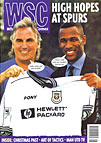 Aside from the bad memories it holds, Roy Chuter examines why Heysel is not safe enough to stage major football matches
Aside from the bad memories it holds, Roy Chuter examines why Heysel is not safe enough to stage major football matches
Of all the places you’d think you have a right to expect to find the latest planning and technology, and where the lessons of eighties disasters would have been most thoroughly learnt, the Heysel Stadium has to be top of the list. But for many of the Irish fans who visited the redeveloped stadium in November, it was obvious that problems remain.
Of course, it’s not called ‘Heysel’ any more. Just as Windscale became Sellafield after the hushed-up nuclear explosion in 1957, so Heysel was renamed ‘The King Baudoin Stadium’, after the Belgian monarch who died while it was being rebuilt. Will the new Wembley follow the same principle, and become ‘The Princess Diana Stadium’? Or even ‘Spice Park’?
Heysel didn’t fall into disuse immediately after the 1985 tragedy, even for international fixtures. The Republic of Ireland drew 2-2 there, thanks to a last-minute Liam Brady penalty, in a European Championship qualifier in 1986 – just sixteen months after the 39 Juventus fans died. At the far end of the ground from where we stood was an unused section of terrace, made up mostly of those parts of dark and grainy brown-grey stone that hadn’t fallen with the Italians, but with a newer portion jaggedly tacked on, spookily noticeable in dusty new-ground white. TV visions of running and tumbling fans, and blood and bodies and desperate medics, came to mind every time the ball went down that end. It had to go.
The place is unrecognizable these days. The crumbling ruin of the early 1980s, which contributed so much to the tragedy, is gone, replaced by one of those soulless, uniform stadia that could have sprung up anywhere in the world, with stands full of plastic moulded seats just big enough for one buttock. Were we in the same end of the ground this time? I couldn’t tell.
The Belgians have taken their own tragedy into account. The shambolic organization has disappeared along with the terraces. Stewards clog the gangways trying to make sure everybody sits down – but because the authorities clearly haven’t studied Hillsborough, they fail.
It is, of course, the fences that are the main problem – tall and heavy enough to turn a scrap-metal dealer into a Jack Walker, and spiked on top. Sitting at the front, with a thinly-meshed gate and its thick iron supports also in the line of view, it was impossible to see much of the pitch. Naturally, we stood up, and were able to see over the top of it – but that meant the people behind us couldn’t see, and had to stand too. Long before the match was over, the stewards had given up asking us to sit – and standing up certainly helped the atmosphere. The same thing will undoubtedly happen at France 98, unless they are persuaded to scrap the fences – which fit no better with seating than they do with terraces.
But even when we could see over the fences, we couldn’t see the whole pitch. Surrounding the pitch are advertising hoardings. They didn’t affect the sight-lines at the back, which were fine – but we couldn’t see the near touchline or the six yards in front of the goal nearest us. And to make matters worse, an enormous mock-up of a can of Belgium’s most tasteless beer stood behind a corner-flag, obscuring a strip that ran diagonally across the pitch. We tried to persuade the chief steward to have it moved. No such luck – the sponsors would be upset.
Then there was the rain. We got soaked. Not as wet as in Benfica’s uncovered Estádio da Luz a couple of years back. And it’s an improvement on Boundary Park, which is aerodynamically designed to ensure that you get wet when it rains (and when does it not?) wherever you are in the ground. But it’s far from perfect. We weren’t the only ones. Parts of the ground, high up along the newest side where the home fans sat, were completely uncovered – though since that side of the ground was a building site in June, and was hastily completed to increase the capacity for the play-off fixture, more work may still be in the offing.
The designers of the New Wembley – and, come to that, Ireland’s ground if the FAI ever get around to building it – need to look at Heysel/King Baudoin. It’s a fine example of how to get it not quite right.
From WSC 131 January 1998. What was happening this month